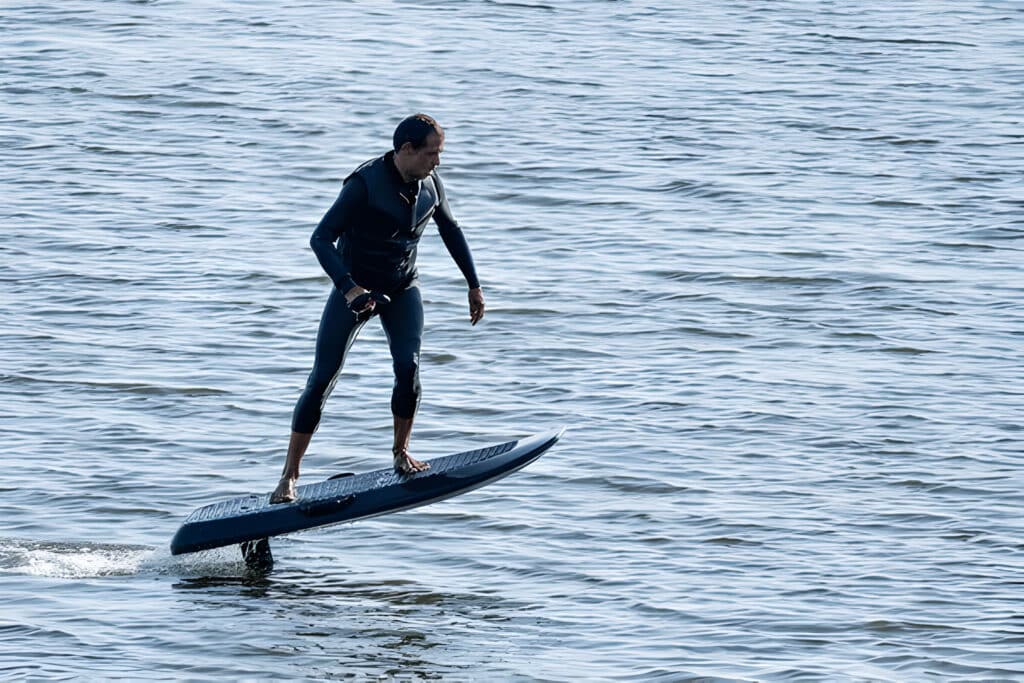Efoil boards are expensive due to a combination of advanced technology, cutting-edge components, and high production costs. These electric-powered hydrofoils typically range from $10,000 to $15,000, making them a significant investment for water sports enthusiasts.
The high price tag of efoils can be attributed to several factors, including their sophisticated electric propulsion systems, frequent design updates, and the use of premium materials. Additionally, the relatively low production volumes and ongoing research and development efforts contribute to their steep cost.
While the demand for efoils continues to grow, limited supply and the complexity of manufacturing these innovative watercraft keep prices elevated. As we delve deeper into the reasons behind their expense, we’ll explore the various elements that make efoils a luxury item in the world of water sports.

Factors Influencing the Cost
Advanced Technology and Cutting-Edge Components
One of the most expensive components in efoil boards is the lithium-ion battery. For instance, some models use lithium-ion batteries with capacities ranging from 1.5 kWh to 3 kWh, which can cost upwards of $1,000 to $2,000 per unit.
The electric motor is another critical component that drives up the efoil cost. These motors are specially designed to be waterproof, efficient, and powerful enough to propel the board and rider through various water conditions. High-quality electric motors suitable for efoil applications can range from $500 to $1,500.
Carbon fiber materials are extensively used in efoil construction, particularly for the board, mast, and foil components. Carbon fiber offers an excellent strength-to-weight ratio, which is crucial for performance and maneuverability. However, this material is significantly more expensive than traditional surfboard materials like fiberglass or epoxy. The cost of carbon fiber can range from $10 to $30 per pound, and a typical efoil board may use several pounds of this material.
The hydrofoil itself is a sophisticated piece of engineering that requires precise manufacturing and high-quality materials. Fliteboard Hydrofoil, for example, uses advanced computer-aided design and manufacturing techniques to produce their foils. The intricate shapes and profiles of these foils are crucial for performance but add to the overall cost of production.
Electronic control systems, including the remote control and onboard computer, are also significant contributors to the efoil’s expense. These systems need to be waterproof, reliable, and capable of withstanding the harsh marine environment. The development and production of these specialized electronic components can cost thousands of dollars per unit.
The propeller system, often featuring designs like a 3-blade prop or folding prop. These specialized propellers can cost several hundred dollars each.
Lastly, the integration of these various high-tech components requires sophisticated engineering and assembly processes. Unlike traditional surfboards or even electric surfboards, efoils demand precision manufacturing and rigorous quality control to ensure all components work seamlessly together. This level of manufacturing complexity adds to the overall cost of production.

Frequent Design Changes
The efoil market is characterized by rapid technological advancements and constant innovation, leading to frequent design changes that significantly impact efoil cost.
One of the primary factors driving these changes is the continuous improvement in lithium-ion batteries. As battery technology evolves, manufacturers like Waydoo efoils and Fliteboard Hydrofoil must adapt their designs to accommodate new power sources. These advancements often result in improved battery duration and power output, but they also necessitate redesigns of the battery box and overall board structure.
The size of efoils is another aspect subject to frequent modifications. Manufacturers experiment with different board lengths and widths to optimize performance in various water conditions, from flat water to outer reef swells. These changes require adjustments to the hydrofoil design and placement, further adding to the complexity and cost of production.
Electric motor technology is also rapidly advancing, with esurf motors becoming more efficient and powerful. As new motor designs emerge, efoil makers must update their propulsion systems, often requiring changes to the foil design and electronic control systems. This constant evolution contributes to the expensive efoil phenomenon, as each iteration requires significant research and development investment.
Low Production Volumes and Lack of Economies of Scale
Unlike mass-produced personal watercraft or traditional surfboards, efoils are still a niche product in the electric hydrofoil market.
Currently, most efoil manufacturers operate on a small scale, producing limited quantities of boards. This approach significantly impacts the efoil cost in several ways:
- Higher per-unit production costs: Without the benefits of large-scale assembly-line production, manufacturers cannot spread fixed costs across a high volume of units. This results in a higher cost per efoil board produced.
- Limited supplier discounts: Smaller production runs mean manufacturers cannot leverage bulk purchasing discounts for components like lithium-ion batteries, electric motors, and carbon fiber materials. As a result, the cost of materials remains high, contributing to the overall expensive efoil price tag.
- Inefficient production processes: Low production volumes often lead to less efficient manufacturing processes. Without the ability to invest in advanced automation and streamlined assembly techniques, production remains labor-intensive and time-consuming, further driving up costs.
- Research and development expenses: The efoil market is still evolving, with frequent design changes and technological advancements. The costs associated with ongoing R&D are spread across fewer units, increasing the price of each board.
To illustrate the impact of production volume on pricing, consider the following comparison:
- A mass-produced electric surfboard might cost around $3,000-$5,000.
- Entry-level efoils, like the Flite AIR – Cheap eFoil, start at around $5,000-$7,000.
- High-end models from established brands like Liftfoils eFoil or Fliteboard Hydrofoil can cost $10,000-$15,000 or more.

High Demand and Limited Supply
The efoil market has experienced a surge in popularity in recent years, leading to a situation of high demand and limited supply. This imbalance contributes significantly to the expensive nature of efoils.
One of the primary factors driving demand is the unique experience that efoils offer. As an addition to water activities, efoils provide a thrilling combination of surfing and flying, appealing to both traditional surfing enthusiasts and those seeking new water sports experiences. This broad appeal has attracted a wide range of users, from experienced surfers to newcomers in the water sports scene.
The combination of high demand and limited supply has created a seller’s market, allowing manufacturers to maintain higher prices. For example, the Liftfoils eFoil and other premium brands can command premium prices due to their reputation and the scarcity of alternatives.
It’s worth noting that the efoil market is still relatively young. As the industry matures and more players enter the market, we may see an increase in supply and potentially lower prices. However, for now, the expensive efoil phenomenon persists due to the imbalance between consumer interest and available products.
For those looking for more affordable options, some companies are working on developing cheaper efoil boards. The Flite AIR, for instance, is marketed as a more accessible “Cheap eFoil” option. Additionally, some enthusiasts explore DIY efoil dreams, attempting to build their own electric hydrofoils. However, these DIY projects often face challenges in sourcing components and achieving the performance and safety standards of commercially produced efoils.
Very Hard to Build It Myself
While the idea of creating a DIY efoil might seem appealing to some enthusiasts, the reality is that building a functional and safe electric hydrofoil is an extremely challenging task. The complexity of efoil designs, coupled with the advanced technology and specialized components required, makes it nearly impossible for the average person to construct their own efoil board.
For those interested in experiencing electric hydrofoiling, purchasing a professionally manufactured efoil from established brands like Waydoo, Fliteboard, or Lift Foils remains the safest and most reliable option. These companies have invested heavily in research, development, and testing to create user-friendly and high-performance efoils suitable for a wide range of water activities.
Conclusion
In conclusion, the high cost of efoils can be attributed to a combination of factors that reflect their cutting-edge nature and the current state of the industry. Advanced technology, frequent design changes, and the use of high-quality components all contribute to the premium price tag. The sophisticated electric propulsion system, coupled with low production volumes and ongoing research and development efforts, further drive up costs. The high demand for efoils, coupled with limited supply, also plays a significant role in maintaining their expensive status.
While the allure of building an efoil oneself may be tempting, the complexity of the task makes it a challenging endeavor for most enthusiasts. As the efoil industry continues to evolve, we may see prices gradually decrease as production scales up and technology becomes more standardized. However, for the foreseeable future, efoils are likely to remain a luxury item for water sports enthusiasts who are willing to invest in this thrilling and innovative form of aquatic recreation.